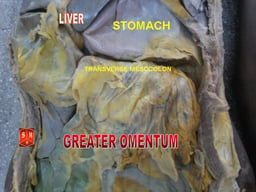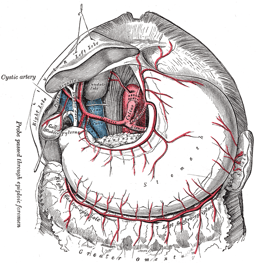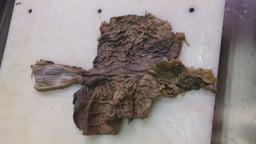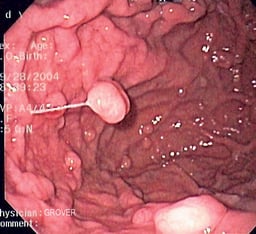Stomach
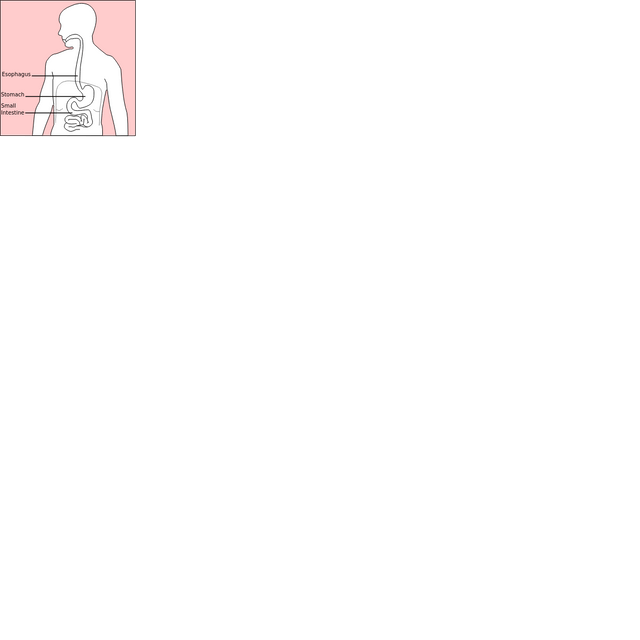
Stomach

| Stomach | |
|---|---|
| Details | |
| Precursor | Foregut |
| System | Digestive system |
| Artery | Right gastric artery,left gastric artery,right gastro-omental artery,left gastro-omental artery,short gastric arteries |
| Vein | Right gastric vein,left gastric vein,right gastroepiploic vein,left gastroepiploic vein,short gastric veins |
| Nerve | Celiac ganglia,vagus nerve[2] |
| Lymph | Celiac lymph nodes[3] |
| Identifiers | |
| Latin | Ventriculus |
| Greek | Gaster |
| MeSH | D013270[58] |
| TA | A05.5.01.001[59] |
| FMA | 7148[60] |
| Anatomical terminology | |
The stomach is a muscular, hollow organ in the gastrointestinal tract of humans and many other animals, including several invertebrates. The stomach has a dilated structure and functions as a vital digestive organ. In the digestive system the stomach is involved in the second phase of digestion, following chewing. It performs a chemical breakdown due to enzymes and hydrochloric acid.
In humans and many other animals, the stomach is located between the oesophagus and the small intestine. It secretes digestive enzymes and gastric acid to aid in food digestion. The pyloric sphincter controls the passage of partially digested food (chyme) from the stomach into the duodenum where peristalsis takes over to move this through the rest of the intestines.
| Stomach | |
|---|---|
| Details | |
| Precursor | Foregut |
| System | Digestive system |
| Artery | Right gastric artery,left gastric artery,right gastro-omental artery,left gastro-omental artery,short gastric arteries |
| Vein | Right gastric vein,left gastric vein,right gastroepiploic vein,left gastroepiploic vein,short gastric veins |
| Nerve | Celiac ganglia,vagus nerve[2] |
| Lymph | Celiac lymph nodes[3] |
| Identifiers | |
| Latin | Ventriculus |
| Greek | Gaster |
| MeSH | D013270[58] |
| TA | A05.5.01.001[59] |
| FMA | 7148[60] |
| Anatomical terminology | |
Structure
In humans, the stomach lies between the oesophagus and the duodenum (the first part of the small intestine). It is in the left upper part of the abdominal cavity. The top of the stomach lies against the diaphragm. Lying behind the stomach is the pancreas. A large double fold of visceral peritoneum called the greater omentum hangs down from the greater curvature of the stomach. Two sphincters keep the contents of the stomach contained; the lower oesophageal sphincter (found in the cardiac region), at the junction of the oesophagus and stomach, and the pyloric sphincter at the junction of the stomach with the duodenum.
The stomach is surrounded by parasympathetic (stimulant) and sympathetic (inhibitor) plexuses (networks of blood vessels and nerves in the anterior gastric, posterior, superior and inferior, celiac and myenteric), which regulate both the secretory activity of the stomach and the motor (motion) activity of its muscles.
In adult humans, the stomach has a relaxed, near empty volume of about 75 millilitres.[4] Because it is a distensible organ, it normally expands to hold about one litre of food.[5] The stomach of a newborn human baby will only be able to retain about 30 millilitres. The maximum stomach volume in adults is between 2 and 4 litres.[6][7]
Sections

Sections of the human stomach
In classical anatomy the human stomach is divided into four sections, beginning at the cardia,[8] each of which has different cells and functions.
The cardia is where the contents of the esophagus empty into the stomach. [9]
The fundus (from Latin, meaning 'bottom') is formed in the upper curved part.
The body is the main, central region of the stomach.
The pylorus (from Greek, meaning 'gatekeeper') is the lower section of the stomach that empties contents into the duodenum.
The cardia is defined as the region following the "z-line" of the gastroesophageal junction, the point at which the epithelium changes from stratified squamous to columnar. Near the cardia is the lower oesophageal sphincter.[9] Recent research has shown that the cardia is not an anatomically distinct region of the stomach but region of the oesophageal lining damaged by reflux.[10]
Relations
The stomach bed refers to the structures upon which the stomach rests in mammals.[11][12] These include the pancreas, spleen, left kidney, left suprarenal gland, transverse colon and its mesocolon, and the diaphragm. The term was introduced around 1896 by Philip Polson of the Catholic University School of Medicine, Dublin. However this was brought into disrepute by surgeon anatomist J Massey.[13][14][15]
Blood supply
The lesser curvature of the human stomach is supplied by the right gastric artery inferiorly and the left gastric artery superiorly, which also supplies the cardiac region. The greater curvature is supplied by the right gastroepiploic artery inferiorly and the left gastroepiploic artery superiorly. The fundus of the stomach, and also the upper portion of the greater curvature, is supplied by the short gastric artery, which arises from the splenic artery.
Microanatomy
Wall
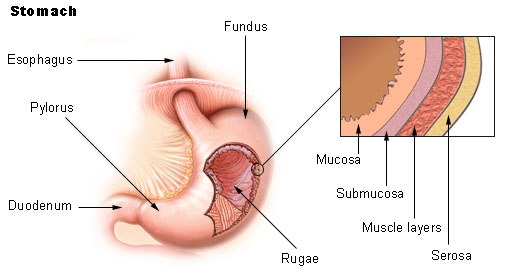
The gastrointestinal wall of the human stomach.
Like the other parts of the gastrointestinal tract, the human stomach walls consist of an outer mucosa, inner submucosa, muscularis externa, and serosa.
The gastric mucosa of the stomach consists of the epithelium and the lamina propria (composed of loose connective tissue), with a thin layer of smooth muscle called the muscularis mucosae separating it from the submucosa beneath. The submucosa lies under the mucosa and consists of fibrous connective tissue, separating the mucosa from the next layer. Meissner's plexus is in this layer. The muscularis externa lies beneath the submucosa and is unique from other organs of the gastrointestinal tract, consisting of three layers:
The inner oblique layer: This layer is responsible for creating the motion that churns and physically breaks down the food. It is the only layer of the three which is not seen in other parts of the digestive system. The antrum has thicker skin cells in its walls and performs more forceful contractions than the fundus.
The middle circular layer: At this layer, the pylorus is surrounded by a thick circular muscular wall, which is normally tonically constricted, forming a functional (if not anatomically discrete) pyloric sphincter, which controls the movement of chyme into the duodenum. This layer is concentric to the longitudinal axis of the stomach.
Auerbach's plexus (AKA myenteric plexus) is found between the outer longitudinal and the middle circular layer and is responsible for the innervation of both (causing peristalsis and mixing)
The outer longitudinal layer is responsible for moving the bolus towards the pylorus of the stomach through muscular shortening.
The stomach also possesses a serosa, consisting of layers of connective tissue continuous with the peritoneum.
Glands

Micrograph showing a cross section of the human stomach wall in the body portion of the stomach. H&E stain.
In humans, different types of cells are found at the different layers of the gastric glands. The three types of glands are all located beneath the gastric pits within the gastric mucosa–the mucous membrane of the stomach. The gastric mucosa is pitted with innumerable gastric pits, which house the gastric glands.
The cardiac glands are found in the cardia of the stomach, enclosing the opening where the esophagus joins to the stomach. Only cardiac glands are found here and they primarily secrete mucus.[17] They are fewer in number than the other gastric glands and are more shallowly positioned in the mucosa. There are two kinds - either simple tubular with short ducts or compound racemose resembling the duodenal Brunner's glands
The fundic glands, are found in the fundus and body of the stomach. They are simple almost straight tubes, two or more of which open into a single duct. They secrete hydrochloric acid (HCl) and intrinsic factor.[17]
The pyloric glands are located in the antrum of the pylorus. They secrete gastrin produced by their G cells.[17]
Gene and protein expression
About 20,000 protein coding genes are expressed in human cells and nearly 70% of these genes are expressed in the normal stomach.[19][20] Just over 150 of these genes are more specifically expressed in the stomach compared to other organs, with only some 20 genes being highly specific. The corresponding specific proteins expressed in stomach are mainly involved in creating a suitable environment for handling the digestion of food for uptake of nutrients. Highly stomach-specific proteins include GKN1, expressed in the mucosa; pepsinogen PGC and the lipase LIPF, expressed in chief cells; and gastric ATPase ATP4A and gastric intrinsic factor GIF, expressed in parietal cells.[21]
Development
In early human embryogenesis, the ventral part of the embryo abuts the yolk sac. During the second week of development, as the embryo grows, it begins to surround parts of the sac. The enveloped portions form the basis for the adult gastrointestinal tract.[22] The sac is surrounded by a network of vitelline arteries. Over time, these arteries consolidate into the three main arteries that supply the developing gastrointestinal tract: the celiac artery, superior mesenteric artery, and inferior mesenteric artery. The areas supplied by these arteries are used to define the foregut, midgut, and hindgut.[22] The surrounded sac becomes the primitive gut. Sections of this gut begin to differentiate into the organs of the gastrointestinal tract, and the esophagus, and stomach form from the foregut.[22]
Function
Digestion
In the human digestive system, a bolus (a small rounded mass of chewed up food) enters the stomach through the esophagus via the lower esophageal sphincter. The stomach releases proteases (protein-digesting enzymes such as pepsin) and hydrochloric acid, which kills or inhibits bacteria and provides the acidic pH of 2 for the proteases to work. Food is churned by the stomach through muscular contractions of the wall called peristalsis – reducing the volume of the bolus, before looping around the fundus[23] and the body of stomach as the boluses are converted into chyme (partially digested food). Chyme slowly passes through the pyloric sphincter and into the duodenum of the small intestine, where the extraction of nutrients begins. Depending on the quantity and contents of the meal, the stomach will digest the food into chyme within anywhere between forty minutes and a few hours. The average human stomach can comfortably hold about a litre of food.
Gastric juice in the stomach also contains pepsinogen. Hydrochloric acid activates this inactive form of enzyme into the active form, pepsin. Pepsin breaks down proteins into polypeptides.
Absorption
Although the absorption in the human digestive system is mainly a function of the small intestine, some absorption of certain small molecules nevertheless does occur in the stomach through its lining.
This includes:
The parietal cells of the human stomach are responsible for producing intrinsic factor, which is necessary for the absorption of vitamin B12. B12 is used in cellular metabolism and is necessary for the production of red blood cells, and the functioning of the nervous system.
Control of secretion and motility
The movement and the flow of chemicals into the stomach are controlled by both the autonomic nervous system and by the various digestive hormones of the digestive system:
| Gastrin | The hormonegastrincauses an increase in the secretion of HCl from the parietal cells, and pepsinogen from chief cells in the stomach.It also causes increased motility in the stomach.Gastrin is released byG cellsin the stomach in response to distension of the antrum, and digestive products (especially large quantities of incompletely digested proteins).It is inhibited by apHnormally less than 4 (high acid), as well as the hormonesomatostatin. |
| Cholecystokinin | Cholecystokinin(CCK) has most effect on thegall bladder, causing gall bladder contractions, but it also decreases gastric emptying and increases release ofpancreaticjuice, which is alkaline and neutralizes the chyme.CCK is synthesized by I-cells in the mucosal epithelium of the small intestine. |
| Secretin | In a different and rare manner,secretinwhich has most effects on the pancreas, also diminish acid secretion in the stomach.Secretin is synthesized byS-cellswhich are located in the duodenal mucosa as well as in the jejunal mucosa in smaller numbers. |
| Gastric inhibitory peptide | Gastric inhibitory peptide(GIP) decreases both gastric acid release and motility.GIP is synthesized by K-cells which are located in the duodenal and jejunal mucosa. |
| Enteroglucagon | Enteroglucagondecreases both gastric acid and motility. |
Other than gastrin, these hormones all act to turn off the stomach action.
This is in response to food products in the liver and gall bladder, which have not yet been absorbed. The stomach needs to push food into the small intestine only when the intestine is not busy. While the intestine is full and still digesting food, the stomach acts as storage for food.
Other
- Effects of EGF
Epidermal growth factor (EGF) results in cellular proliferation, differentiation, and survival.[28] EGF is a low-molecular-weight polypeptide first purified from the mouse submandibular gland, but since then found in many human tissues including the submandibular gland, and the parotid gland. Salivary EGF, which also seems to be regulated by dietary inorganic iodine, also plays an important physiological role in the maintenance of oro-oesophageal and gastric tissue integrity. The biological effects of salivary EGF include healing of oral and gastroesophageal ulcers, inhibition of gastric acid secretion, stimulation of DNA synthesis, and mucosal protection from intraluminal injurious factors such as gastric acid, bile acids, pepsin, and trypsin and from physical, chemical, and bacterial agents.[29]
- Stomach as nutrition sensor
The human stomach can "taste" sodium glutamate using glutamate receptors[30] and this information is passed to the lateral hypothalamus and limbic system in the brain as a palatability signal through the vagus nerve.[31] The stomach can also sense, independently of tongue and oral taste receptors, glucose,[32] carbohydrates,[33] proteins,[33] and fats.[34] This allows the brain to link nutritional value of foods to their tastes.[32]
Clinical significance
Diseases
A series of radiographs can be used to examine the stomach for various disorders. This will often include the use of a barium swallow. Another method of examination of the stomach, is the use of an endoscope. A gastric emptying scan is considered the gold standard to assess gastric emptying rate.[35]
A large number of studies have indicated that most cases of peptic ulcers, and gastritis, in humans are caused by Helicobacter pylori infection, and an association has been seen with the development of stomach cancer.[36]
A stomach rumble is actually noise from the intestines. The stomach has to regenerate a new layer of mucus every two weeks, or else damage to the epithelium may result.
Surgery
In humans, many bariatric surgery procedures involve the stomach, in order to lose weight. A gastric band may be placed around the cardia area, which can adjust to limit intake. The anatomy of the stomach may be modified, or the stomach may be bypassed entirely.
Surgical removal of the stomach is called a gastrectomy, and removal of the cardia area is a called a cardiectomy. "Cardiectomy" is a term that is also used to describe the removal of the heart.[37][38][39] A gastrectomy may be carried out because of gastric cancer or severe perforation of the stomach wall.
Fundoplication is stomach surgery in which the fundus is wrapped around the lower esophagus and stitched into place. It is used to treat gastroesophageal reflux disease (GERD).[40]
History
There were previously conflicting statements in the academic anatomy community[41][42][43] over whether the cardia is part of the stomach, part of the oesophagus or a distinct entity. Modern surgical and medical textbooks have agreed that "The gastric cardia is now clearly considered to be part of the stomach."[44][45]
Etymology
The word stomach is derived from the Latin stomachus which has roots from the Greek word stomachos (στόμαχος), ultimately from stoma (στόμα), "mouth".[46]The%20Oxford%20English%20diction]]The words gastriche stomach) are both derived from the Greek word gaster*(γαστήρ, meaning "belly"[47][48]).[[46]](https://openlibrary.org/search?q=Simpson%2C%20J.%20A.%20%281989%29.%20* [[CITE|46|https://openlibrary.org/search?q=Simpson%2C%20J.%20A.%20%281989%29.%20*The%20Oxford%20English%20diction)
Other animals
Although the precise shape and size of the stomach varies widely among different vertebrates, the relative positions of the oesophageal and duodenal openings remain relatively constant.
As a result, the organ always curves somewhat to the left before curving back to meet the pyloric sphincter.
However, lampreys, hagfishes, chimaeras, lungfishes, and some teleost fish have no stomach at all, with the oesophagus opening directly into the anus. These animals all consume diets that either require little storage of food, or no pre-digestion with gastric juices, or both.[53]
The gastric lining is usually divided into two regions, an anterior portion lined by fundic glands, and a posterior with pyloric glands.
Cardiac glands are unique to mammals, and even then are absent in a number of species. The distributions of these glands vary between species, and do not always correspond with the same regions as in humans. Furthermore, in many non-human mammals, a portion of the stomach anterior to the cardiac glands is lined with epithelium essentially identical to that of the oesophagus. Ruminants, in particular, have a complex stomach, the first three chambers of which are all lined with oesophageal mucosa.[53]
In birds and crocodilians, the stomach is divided into two regions. Anteriorly is a narrow tubular region, the proventriculus, lined by fundic glands, and connecting the true stomach to the crop. Beyond lies the powerful muscular gizzard, lined by pyloric glands, and, in some species, containing stones that the animal swallows to help grind up food.[53]
In insects there is also a crop. The insect stomach is called the midgut.
Information about the stomach in echinoderms or molluscs can be found under the respective articles.
Additional images
See also
Gut flora
Gastroesophageal reflux disease
Proton pump inhibitors
